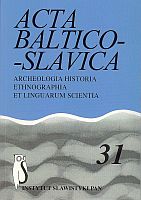O przypuszczalnych wpływach litewskich w „Słowniku dialektu knyszyńskiego” Czesława Kudzinowskiego
On supposed Lithuanian influences in Czeslaw Kudzinowski "Vocabulary of the dialect of the Knyszyn region"
Author(s): Dorota Krystyna RembiszewskaSubject(s): Language and Literature Studies
Published by: Instytut Slawistyki Polskiej Akademii Nauk
Keywords: linguistics; dialectology; baltisms; Podlassia; Knyszyn
Summary/Abstract: This article continues the reflections on the Lithuanian influences in Czesław Kudzinowski’s Słownik dialektu knyszyńskiego (Vocabulary of the dialect of the Knyszyn region), presented in the 30th volume of ABS – Wpływy bałtyckie w “Słowniku dialektu knyszyńskiego” Czesława Kudzinowskiego (Baltic influences in Czesław Kudzinowski’s Vocabulary of the dialect of the Knyszyn region).The abovementioned vocabulary is concerned with the lexis of the north-western part of Podlassia, where various interferences and foreign influences can be found, in terms of the neighbouring Lithuanian and East-Slavic language territories. In my paper I am concerned with names that are considered Lithuanian by some researchers, including Czesław Kudzinowski. That refers to words which might possibly have Lithuanian roots. In this group I included: bit.n ‘milk pot’, bl.ć ‘1. bleć; 2. cry (peior.)’, xr.mstka ‘cartilage’, .igać ‘jump’, .igafka ‘skipping rope’, m.rgać, ‘glow, shine’, ..rescyć, wy..rescyć ‘hit, give a hiding’, ru..ć ‘take interest’. I also distinguished a group of names, which have rather not been influenced by the Lithuanian language: blata ‘board (oven)’, bołb.t ‘speaking inarticulately’, buń, buńa, buńka ‘kettle’, cmut ‘magic’, dra.ka ‘splinter (used for lighting up)’, gamoła ‘1. gomoła; 2. fool’, gimźava ‘swarming’, gunt ‘shingle’, gramozda ‘oaf ’, grust ‘kind of mushroom’, gruź.ł ‘knot’, hurba ‘pile, heap, drift’, karvasy ‘1. snatches of clothing, ream; 2. hair drooping on the neck’, kl.ć‘ ‘chamber, store-room, granary, storehouse’, kuća ‘dish (Christmas) made of orge with poppy seed and honey’, kudektać ‘cluck’, lalka ‘1. doll; 2. eye-pupil’, luśńa, luśńa.ka ‘bar on a cart, connecting the axle with the ladder’, manić ‘decive’, .tava ‘secondary grass to be cut’, pałuba ‘shed on a Gypsy cart-load’, pasuki ‘flocks’, ..r.k ‘yeast cake’, pipka ‘pipe’, pleva ‘1. chaff; 2. membrane’, plita ‘1. board; 2. flat stone; 3. board (kitchen)’, poł.ć ‘slice of fatback’, p...tka ‘kind of shed’, prycupn.ńć ‘1. nestle; 2. grab’, pyla ‘chasing off ducks’, rysa ‘at a trot’, śab.r ‘fellow, companion’, śulić ‘persuade sth. to sb., recommend’, śorbać ‘drink loudly’, śp.rka ‘fatback’, tr.jlovać ‘babble, talk nonsense’, uśp.ć ‘make it’, zago..ć ‘end the fast’. The analyzed words are distinguished by different levels of association with the Lithuanian language. The relationship with the Lithuanian language is difficult to establish for some of these words. There were also names of undoubtedly different origins (e.g. germanisms, words stemming from the region of Galicja), as well as prerelated – baltoslavic.
Journal: Acta Baltico Slavica
- Issue Year: 2007
- Issue No: 31
- Page Range: 213-234
- Page Count: 22
- Language: Polish

